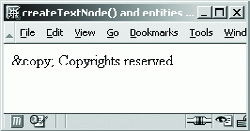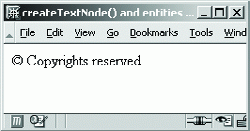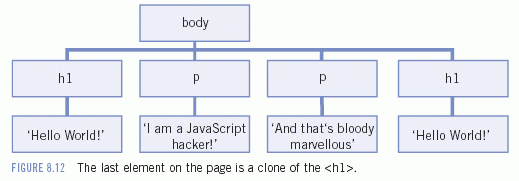PPK on JavaScript: The DOM - Part 2/Page 2
[previous] [next]
PPK on JavaScript: The DOM - Part 2
createTextNode() and HTML entities
There's one problem with createTextNode(): it cannot create HTML entities like © or —. Instead of the symbol you need, it creates the literal text:

Figure 8.10:
createTextNode() cannot create HTML entities.
Use innerHTML instead:

Figure 8.11: Solution - use innerHTML.
cloneNode()
The cloneNode() method clones a node; that is, it makes a near-exact copy of the node, which you can subsequently insert in the document tree. For instance:
I take the first <h1> in the document and clone it. Then I append the clone to the <body>.

cloneNode() has a couple of features you must know about in order to use it properly:
cloneNode()expects an argumenttrueorfalse.truemeans "Clone the element and all its child nodes."falsemeans "Clone the element but not its child nodes." In practice, you always usetrue; I have never yet encountered a situation in which you want to clone a node but not its children.cloneNode()does not clone event handlers. This is extremely annoying, but it's how the method was specified. (Why? I have no idea.) So every time you clone a node with event handlers, you have to redefine them on the clone.
Sandwich Picker contains a useful example of all this. Every sandwich should have its own Order and Trash buttons, and of course these dozens of buttons are exactly the same. This is a typical job for cloneNode()!
At the start of the initialization function, I create one trashLink and one orderLink as template nodes. Note that I use innerHTML to create the link texts: I need a for CSS reasons, and createTextNode() doesn't allow me to insert it.
Later, when I go through all <tr>s in the order table, I clone these two templates, add the correct event handlers, and insert them into the document.
Every sandwich <tr> has a searchField form field. Since the buttons should appear underneath this form field, I append them to searchField.parentNode: the <td>.
Note that I assign the event handlers only after the buttons have been cloned. They would not survive the cloning process.
[previous] [next]
URL:


 Find a programming school near you
Find a programming school near you